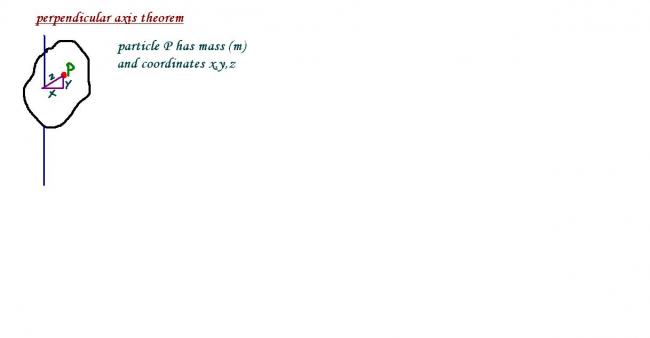perpendicular axis theorem is for laminar bodies.. and is more or less a direct result of the pythagoras theorem.
parallel axis proof is also kind of simple....feeling very lazy now.
maybe someone who doesnt know this should try first.
Prove Perpendicular and Parallel axis theorem.
Hint: for perp axis thm: Think of why Ix+Iy=Iz is valid only on one plane :P
I was teaching recently and suddenly wondered why i never asked this as a QOD here :P
perpendicular axis theorem is for laminar bodies.. and is more or less a direct result of the pythagoras theorem.
parallel axis proof is also kind of simple....feeling very lazy now.
maybe someone who doesnt know this should try first.
PERPENDICULAR AXIS THEOREM :
x2 + y2 = z2
=> mx2 + my2 = mz2
=> Σ mx2 + Σmy2 = Σmz2
=> IX + IY = IZ
THIS THEOREM IS NOT APPLICABLE FOR A BODY WHICH IS SYMMETRIC ABOUT ALL THREE AXES !
(similarly for parallel axis theorem !)

is Ix = Σ m x2 ??
Think of a rod placed along the Y axis...
x = 0 there.. then the moment of inertia of the rod about the X axis should have been zero!
hmmm I agree that the notation is a bit confusing perhaps
however;
we define the second moment of inertia of a body about an axis O
such that
I_0=\sum{m_ir^2}
where r is the _|_ distance of the ith particle from the axis O.
so particularly for laminar bodies it is clear that
I_x=\sum{m_iy^2} \\and \ I_y=\sum{m_ix^2}
where x and y are the 'x' and 'y' coordinates respectively of the ith particle in the respective equations
now the _|_ distance from the z axis of any point (x,y) on the x, y plane is √x2+y2
so I_z=\sum{m_i(x^2+y^2)}=I_y+I_x
Anyone trying parallel axis theorem.... ?
Hint : Start from the definition I gave in #5
the rest is algebra and common sense